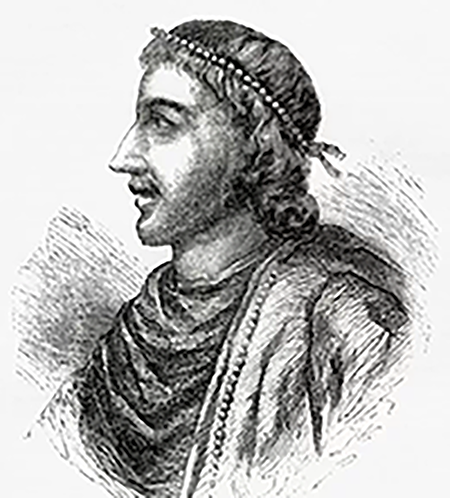



King Cnut the Great - Quick Stats




Born: c.995 AD (likely in Denmark)
King Cnut the Great: The Viking Who Forged an Empire Across the North Sea
King Cnut ( Canute, Knut) the Great (c. 995Ė1035) is one of the most remarkable figures in medieval history, remembered as a Viking king who forged a vast empire and presided over a transformative era in northern Europe. Ruling England, Denmark, Norway, and parts of Sweden, Cnut united diverse territories and cultures under what became known as the North Sea Empire. A skilled warrior, astute politician, and devout Christian, Cnut embodied a unique blend of Viking tradition and European statecraft.
Early Life and Viking Heritage
Cnut was born around 995 CE, likely in Denmark, into a family of significant Viking leaders. His father, Sweyn Forkbeard, was a fierce warrior who waged numerous campaigns across Europe, eventually claiming the English throne in 1013. Cnutís grandfather, Harald Bluetooth, had unified Denmark and Norway while introducing Christianity to Scandinavia, setting the stage for the regionís gradual Christianization.
Cnut was born around 995 CE, likely in Denmark, into a family of significant Viking leaders. His father, Sweyn Forkbeard, was a fierce warrior who waged numerous campaigns across Europe, eventually claiming the English throne in 1013. Cnutís grandfather, Harald Bluetooth, had unified Denmark and Norway while introducing Christianity to Scandinavia, setting the stage for the regionís gradual Christianization.
Cnutís mother is less well-documented, but many sources suggest she was Swietoslawa, also known as Gunhild, a Polish noblewoman. This connection would have linked Cnut to powerful dynastic networks in Europe. Raised in the martial Viking tradition, Cnut likely received training in combat, navigation, and leadership from an early age, preparing him for the challenges of rule and conquest.
Sweyn Forkbeard and the English Conquest
In 1013, Cnut accompanied his father, Sweyn Forkbeard, during his invasion of England. This campaign was the culmination of decades of Viking raids on Anglo-Saxon lands. Sweynís forces overwhelmed the English, forcing King ∆thelred the Unready to flee to Normandy. Sweyn declared himself King of England, becoming the first Viking to hold the English crown.
In 1013, Cnut accompanied his father, Sweyn Forkbeard, during his invasion of England. This campaign was the culmination of decades of Viking raids on Anglo-Saxon lands. Sweynís forces overwhelmed the English, forcing King ∆thelred the Unready to flee to Normandy. Sweyn declared himself King of England, becoming the first Viking to hold the English crown.
Cnutís Personal Life and Family
Cnutís personal life was closely tied to his political strategy. In 1017, he married Emma of Normandy, the widow of King ∆thelred the Unready. This union helped legitimize his rule in England and strengthened ties with Normandy, a rising power in Europe. Together, they had a son, Harthacnut, who would later inherit Cnutís Scandinavian territories.
Cnutís personal life was closely tied to his political strategy. In 1017, he married Emma of Normandy, the widow of King ∆thelred the Unready. This union helped legitimize his rule in England and strengthened ties with Normandy, a rising power in Europe. Together, they had a son, Harthacnut, who would later inherit Cnutís Scandinavian territories.
While the historical accuracy of this story is debated, it remains a powerful symbol of the relationship between power, humility, and faith in medieval kingship.
The North Sea Empire
While England was central to Cnutís realm, his ambitions extended far beyond its borders. In 1018, following the death of his brother Harald II, Cnut became King of Denmark, uniting the two kingdoms under his rule. This marked the foundation of the North Sea Empire, a political entity that spanned England, Denmark, Norway, and parts of Sweden.
While England was central to Cnutís realm, his ambitions extended far beyond its borders. In 1018, following the death of his brother Harald II, Cnut became King of Denmark, uniting the two kingdoms under his rule. This marked the foundation of the North Sea Empire, a political entity that spanned England, Denmark, Norway, and parts of Sweden.
Cnutís Campaign to Reclaim England
Determined to avenge his fatherís death and claim the English throne, Cnut launched a new invasion in 1015. This campaign was marked by strategic brilliance and ruthless determination. Cnutís forces, bolstered by his alliances in Scandinavia, systematically defeated the English resistance.
Determined to avenge his fatherís death and claim the English throne, Cnut launched a new invasion in 1015. This campaign was marked by strategic brilliance and ruthless determination. Cnutís forces, bolstered by his alliances in Scandinavia, systematically defeated the English resistance.
Children: With ∆lfgifu
Emma of Normandy
Wives: ∆lfgifu of Northampton
Father: Seywn Forkbeard
Mother: Possibly Swietoslawa
Died: 12 November 1035 AD (Shaftesbury Uk)
Harold Harefoot
Svein Knutsson
Beyond his historical achievements, Cnut is also enshrined in legend. Among the most enduring tales is the story of King Cnut and the tide, a parable of humility and the limits of royal power. This article explores Cnutís life and legacy, blending historical detail with the legendary anecdotes that make his story so compelling.
However, Sweynís triumph was short-lived. He died suddenly in February 1014, leaving England in disarray. The English nobility invited ∆thelred back to the throne, and Cnut, then a young warrior, retreated to Denmark to regroup. This abrupt reversal set the stage for Cnutís eventual conquest
The decisive moment came in 1016 at the Battle of Assandun, where Cnutís army clashed with the forces of Edmund Ironside, son of ∆thelred. Cnutís victory forced Edmund to negotiate the Treaty of Alney, which divided England between them. However, Edmundís sudden death later that year left Cnut as the sole ruler of England.
Ruling England: Stability and Reform
Cnutís rule over England began in 1017, and he quickly moved to consolidate power. Recognizing the importance of stability, he retained much of the existing Anglo-Saxon administrative structure, including the use of shires and hundreds for local governance. Cnut also rewarded loyal supporters, both Danish and English, with land and titles, fostering a network of alliances that strengthened his rule.
Cnutís rule over England began in 1017, and he quickly moved to consolidate power. Recognizing the importance of stability, he retained much of the existing Anglo-Saxon administrative structure, including the use of shires and hundreds for local governance. Cnut also rewarded loyal supporters, both Danish and English, with land and titles, fostering a network of alliances that strengthened his rule.
Cnutís reign was marked by relative peace and prosperity. He reintroduced the heregeld, a tax used to maintain a standing army and navy, ensuring that England was well-defended. He also supported trade and agricultural development, contributing to economic growth.
As a devout Christian, Cnut sought to atone for the Viking plundering of the past by supporting the Church. He endowed monasteries, built churches, and promoted religious reforms. His pilgrimage to Rome in 1027, where he attended the coronation of Holy Roman Emperor Conrad II, showcased his commitment to Christianity and his status as a European statesman.
Cnut also had children from his earlier relationship with ∆lfgifu of Northampton, including Harold Harefoot, who succeeded him as King of England. These competing claims to the throne would later lead to disputes that weakened the North Sea Empire.
Cnutís Death and Legacy
Cnut died on 12 November 1035, likely in Shaftesbury, England. He was buried in Winchester, a city that had become a center of royal power under his reign. His death marked the end of an extraordinary chapter in medieval history.
Cnut died on 12 November 1035, likely in Shaftesbury, England. He was buried in Winchester, a city that had become a center of royal power under his reign. His death marked the end of an extraordinary chapter in medieval history.
The North Sea Empire he built began to fragment soon after his passing. England, Denmark, and Norway each fell under separate rulers, and the unity Cnut had worked to achieve was lost.
Despite the collapse of his empire, Cnutís legacy endured. He is remembered as a ruler who combined Viking traditions with Christian values, creating a model of governance that brought stability and prosperity to his realms. The story of King Cnut and the tide, whether fact or fiction, serves as a timeless reminder of the balance between power, humility, and the natural order.
In 1028, Cnut launched a successful campaign to conquer Norway, overthrowing King Olaf II. By combining military strength with diplomatic alliances, Cnut secured his dominance over Scandinavia. His influence extended to parts of Scotland as well, where local rulers paid him homage.
Cnutís empire was unprecedented in its scope, linking the British Isles and Scandinavia in a unified political and economic network.
Through his vision, diplomacy, and leadership, King Cnut the Great secured his place as one of the most remarkable monarchs in European history. His reign not only transformed the lands he ruled but also left an indelible mark on the cultural and political landscape of medieval Europe.

Children: With Emma of Normandy
Harthacnut
Gunhilda
Predecessor: Edmund Ironside
Successor: Harold Harefoot

The Story of King Cnut and the Tide
One of the most famous anecdotes associated with Cnut is the story of him attempting to command the tide. According to legend, Cnut placed his throne on the seashore and ordered the waves to stop advancing. When the tide continued to rise, he turned to his courtiers and declared that no king, however powerful, could command nature.
One of the most famous anecdotes associated with Cnut is the story of him attempting to command the tide. According to legend, Cnut placed his throne on the seashore and ordered the waves to stop advancing. When the tide continued to rise, he turned to his courtiers and declared that no king, however powerful, could command nature.
This tale, often misinterpreted as an example of royal hubris, was actually meant to demonstrate Cnutís humility and acknowledgment of divine power. By showing that even a kingís authority had limits, Cnut reminded his followers of the importance of reverence toward God.
King Cnut Demanding The Tide To Stop


